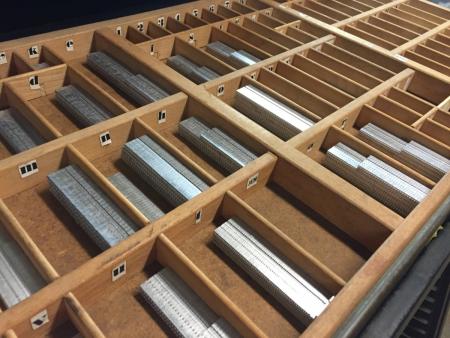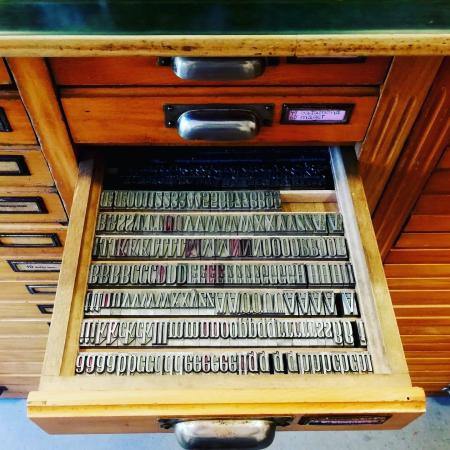How to correctly store type in case
I’m assuming having a jumbled lot of loose type in each division of a case is not conducive to the life of the type.
So what is correct to lay the type on its side and Stack them?
Stand them on end so you can see the faces and identify the type?
Do you place any packing to fill the empty space?
Photos from the net.

9C70E868-5A9E-4D24-B364-D50AC569DC7F.jpeg

A167DB44-ACCC-42EF-8A3F-879767073404.jpeg
Stacking type like that seems to be a somewhat new, and peculiarly American habit. We are apparently the only printers with that much time on our hands. It will tend to keep the faces less damaged though…
We have cases in our shop with notes from the 1920s telling the distributors to arrange the type in the case nick up and stacked neatly.
From a U.K. perspective only and from One who has been casting type and filling cases since the mid 50.s and this into standard type cases.!
90% +, in and for production houses, running Monotype where *speed is of the essence* etc. i.e. to make the best possible use of the compartments and in the quickest time available, (generally) run out on the Caster, line by line to about 26 ems Pica, and then dissed into the cases, via the use of a setting rule, with rule used as the ramp ! to slide the columns into the majority of the compartments, which are generally the width of type + 6 pt. in milliseconds flat, the most type located horizontally to view, with the best possible access for setting from, of course l/c c, e, a, n. o. r, s, take 3/4 columns wide but still very fast for locating/dissing in and max. use of space.
Again and generally even display sizes 14 Pt. - 36 Pt. work well in the above format.
48 Pt. 60 Pt. & 72 Pt. usually treated differently, because of the weight and size, located upright, with as little as 2 characters per compartment, 72 Pt. Cap (W) cap (M) etc. for example.
N. B. - U.K. perspective only and One operators method.
Great comments, Mick! I’m so glad that we have the benefit of your long experience.
In the mid-1800’s, before machine setting was possible, compositors were said to be able to set 1 to 2 newspaper lines per minute. At that speed, I’m sure they didn’t have time to look at what letter they had picked out. They had to assume that the letters were in the right compartments. They grabbed each letter, made sure the nick was up, and went on to the next. Also I think everything was proofed and proofread in those days, so if there was a mistake, the proofreader would mark it with the correct proofreader’s mark, and it would be fixed at that point.
When that type was distributed again, I can’t see that they would have taken the time to place it in the case in any particular way. There was too much type to distribute for that, at least in a newspaper office or book publisher.
The compartments in the cases were bigger as well, since they used upper and lower cases instead of California job cases, so that probably made it easier to hit the right compartment quickly..
Geoffrey, Thank You, yes as You imply way back (again U.K. aspect and only as far back as the mid 50,s) allegedly ! compositors could set 2/3 lines per minute at 13 ems per line, or thereabouts - newsprint columns approx., U.S. the same perhaps.?
`54 - `60, in the general jobbing section of a Newspaper House, the fastest Comp (journeyman) could get nowhere near that rate, especially setting justified lines, as in maybe 5 spaces per line, normally set with a thick or a mid initially, and then justified up or down to suit, would seem to have been a physical impossibility.
Even setting *range left/unjustified* still has to be justified within the setting stick, to the full measure.
With a well trained Monotype Caster operator on sight and with the cases well topped up, when justifying and re- justifying, the thinner spaces would NOT be dissed back in, just recycled, with the exception of >brass< hair spaces.
Geoffrey. Thanks, Mick.
It seems indeed an American habit to stack type in the cases. I’ve been since the late 1960s in many a printshop in Europe and never ever seen anything like that. I also checked some German and Swiss manuals from the same period, where the cases would get a little shake once they were filled with new type, because it would enable the typesetter to work faster! As Mick already indicated, one sets much faster with the type loose in the case. Your eye checks where the nick is, and your fingers turn the characters into the correct position. Here in the Netherlands, type up to 24 pt is generally laid in standard cases, larger sizes set up in narrow cases. One picture shows a so called ‘3/4 case’ with brand new 12 pt Optima, as cast by Rainer Gerstenberg. The second photo is of one of the cases used for the larger sizes.
DSC07326.jpg
DSC07325.jpg
Stacking type really is the passtime of people with too much time on their hands. I know, as I do it a lot.
I don’t think it should be done though. Stacked as it is, if you drop something heavy on the case there’s a good chance you’ll dent the most important face of your type - the printing face, leaving a permanently scarred sort. This maybe isn’t a big deal in an 8pt A32a64 Times Roman, common as muck font, but if you drop a 72pt rare-as-rocking-horse-poo decorative initial onto the face of another 72pt decorative inital you’ll be fuming. Voice of experience.
I generally stack the type with the face to the left and the nick up in larger sizes. The faces I use for book work, 12pt and smaller, I put in the case with the face to the left, but don’t pay attention to the nick position. I find I can get more type in a case by organized stacking, and the face is protected by uniform positioning. I have three or four cases of some particular book faces, and would require even greater number of cases without such order.
John Henry
Cedar Creek Press
Wow! I have managed to accumulate over 2,000 fonts of handset type for my shop in almost 43 years of acquisition and it is extremely rare to find type laid in the case as in the original photo. I do have some cases like this however.
I can tell you that the ones like that in my cvollection were originally held by what one would consider “fine printing” operations (A. Colish, comes immediately to mind) as well as some professional typography shops.
It was my understanding that this kind of time and care was expended to keep the type in absolutely as pristine condition as possible.
AND here is the real kicker - they were sometimes laid in after being used in such a manner that the recently-used type was arranged so that the remaining unused type was more easily available for setting the next time!!!! Basically rotating the type in an attempt to minimize wear.
I honestly did not make that up, but was told that at some time in the foggy distant past. It was simply too amazing not to remember.
Rick
Thomas Gravemaker, don’t forget the Brotschriftkasten, 100 Pfund of type and up to 10 Point Didot.
Y’know, I never even considered stacking type in a CJC. Probably because we didn’t do it in junior high school. Now that I see the examples, I think it might be a pretty good idea. Mostly my print runs are a hobby for me, so time is not really an issue… but learning the case is an issue and keeping the lower case n’s, u’s, p’s & q’s in the correct place is always “fun”. Just now realized where “mind your p’s & q’s” came from!
I saw a shop that had cases of new type and empty cases ready to store used type. Once the new type was all used, then the once-used type would be used in rotation. Nothing was laid out in the compartments in a particular way, but it was nice to not mix new and used type.
When I was young and worked in the composition department of my family printing firm, I was taught to pick up a few words of type between my thumb and forefinger and then, as I positioned each piece of type over the correct compartment of the case, slowly open up my fingers and drop each piece where it belonged. Since the type only dropped a short distance, it sustained very minimal damage, although it didn’t land in any particular orientation in the case. We could distribute type quite fast that way.